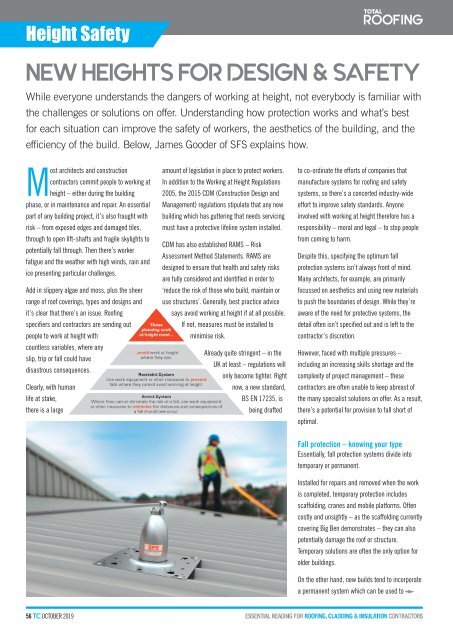October 2019
Create successful ePaper yourself
Turn your PDF publications into a flip-book with our unique Google optimized e-Paper software.
Height Safety<br />
NEW HEIGHTS FOR DESIGN & SAFETY<br />
While everyone understands the dangers of working at height, not everybody is familiar with<br />
the challenges or solutions on offer. Understanding how protection works and what’s best<br />
for each situation can improve the safety of workers, the aesthetics of the building, and the<br />
efficiency of the build. Below, James Gooder of SFS explains how.<br />
Most architects and construction<br />
contractors commit people to working at<br />
height – either during the building<br />
phase, or in maintenance and repair. An essential<br />
part of any building project, it’s also fraught with<br />
risk – from exposed edges and damaged tiles,<br />
through to open lift-shafts and fragile skylights to<br />
potentially fall through. Then there’s worker<br />
fatigue and the weather with high winds, rain and<br />
ice presenting particular challenges.<br />
Add in slippery algae and moss, plus the sheer<br />
range of roof coverings, types and designs and<br />
it’s clear that there’s an issue. Roofing<br />
specifiers and contractors are sending out<br />
people to work at height with<br />
countless variables, where any<br />
slip, trip or fall could have<br />
disastrous consequences.<br />
Clearly, with human<br />
life at stake,<br />
there is a large<br />
amount of legislation in place to protect workers.<br />
In addition to the Working at Height Regulations<br />
2005, the 2015 CDM (Construction Design and<br />
Management) regulations stipulate that any new<br />
building which has guttering that needs servicing<br />
must have a protective lifeline system installed.<br />
CDM has also established RAMS – Risk<br />
Assessment Method Statements. RAMS are<br />
designed to ensure that health and safety risks<br />
are fully considered and identified in order to<br />
‘reduce the risk of those who build, maintain or<br />
use structures’. Generally, best practice advice<br />
says avoid working at height if at all possible.<br />
If not, measures must be installed to<br />
minimise risk.<br />
Already quite stringent – in the<br />
UK at least – regulations will<br />
only become tighter. Right<br />
now, a new standard,<br />
BS EN 17235, is<br />
being drafted<br />
to co-ordinate the efforts of companies that<br />
manufacture systems for roofing and safety<br />
systems, so there’s a concerted industry-wide<br />
effort to improve safety standards. Anyone<br />
involved with working at height therefore has a<br />
responsibility – moral and legal – to stop people<br />
from coming to harm.<br />
Despite this, specifying the optimum fall<br />
protection systems isn’t always front of mind.<br />
Many architects, for example, are primarily<br />
focussed on aesthetics and using new materials<br />
to push the boundaries of design. While they’re<br />
aware of the need for protective systems, the<br />
detail often isn’t specified out and is left to the<br />
contractor’s discretion.<br />
However, faced with multiple pressures –<br />
including an increasing skills shortage and the<br />
complexity of project management – these<br />
contractors are often unable to keep abreast of<br />
the many specialist solutions on offer. As a result,<br />
there’s a potential for provision to fall short of<br />
optimal.<br />
Fall protection – knowing your type<br />
Essentially, fall protection systems divide into<br />
temporary or permanent.<br />
Installed for repairs and removed when the work<br />
is completed, temporary protection includes<br />
scaffolding, cranes and mobile platforms. Often<br />
costly and unsightly – as the scaffolding currently<br />
covering Big Ben demonstrates – they can also<br />
potentially damage the roof or structure.<br />
Temporary solutions are often the only option for<br />
older buildings.<br />
On the other hand, new builds tend to incorporate<br />
a permanent system which can be used to<br />
56 TC OCTOBER <strong>2019</strong>

















